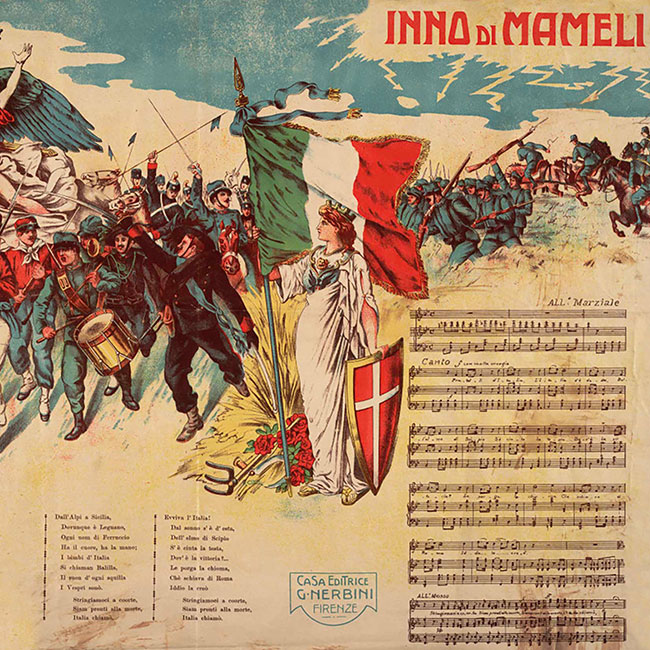Il canto degli italiani (Fratelli d’Italia)

The most surprising historical aspect of Fratelli d’Italia is probably how quickly the verses written by Goffredo Mameli spread and became a battle anthem. In 1847, there were newspapers that printed more opinions and local news than news of the world, because there were no press agencies. But there were none of those modern means of communication, unless we consider the glorious Morse telegraph to be one, at the time not even a decade old. Nonetheless, the anthem spread very rapidly. Il canto degli italiani, as Mameli called his creation, probably began to circulate between October and November, printed on leaflets. In the first version, the opening did not say “Fratelli d’Italia,/ l’Italia s’è desta, but “Evviva l’Italia, / l’Italia s’è desta”. The original manuscript is preserved in the Mazzinian Institute of the Municipality of Genoa, while the Museo del Risorgimento in Turin has a second manuscript: the one that Mameli sent with the date November 10, 1847 to maestro Michele Novaro to provide a musical arrangement. There is some uncertainty as to the dates, and behind this there is actually a small historical-literary mystery concerning the melody to which the verses are set. Initially, Mameli thought of adapting them to existing music, then he turned to two fellow citizens (named Magioncalda and Nosella), whose work however he did not seem very satisfied with. He then turned to Maestro Novaro, having contacted him in Turin.
The official debut date of the anthem is however December 10, 1847, when ll canto degli italiani, jointly written by Mameli and Novaro was presented to the Genoese and patriots of various regions gathered in the Ligurian capital. The occasion was the centennial of the expulsion of the Austrians. The program also included a pilgrimage to the sanctuary of Oregina. As a “preview” of the Statute, the police rule that prohibited gatherings of more than ten people was lifted. About 30,000 came together to enthusiastically intone the notes of Fratelli d’ltalia, while the fires of the so-called “Apennine night” were lit: large bonfires organized by Nino Bixio on the highest peaks, from Monte Fasce to the coast. After a few days, however, everyone knew the anthem, and the Genoese in particular continued to sing it in the demonstrations of a growing liveliness that continued in the city. The lack of microphones and amplification systems was no obstacle. Nor was the popularity limited to Liguria, because a few months later there was a real trial by fire in Lombardy: between the firing of rifles and cannon shots, Fratelli d’ltalia confirmed its catchiness and power to pull people in on the barricades of the Five Days of Milan (March 18-23, 1848), where the insurgents filled their lungs and bellowed out Il canto degli italiani Il canto degli italiani by Goffredo Mameli and maestro Michele Novaro.
Excerpt from: Tarquinio Maiorino, Giuseppe Marchetti and Piero Giordana, Fratelli d’Italia. La vera storia dell’inno di Mameli, Mondadori: Mi, 2001, pp.17-18.
